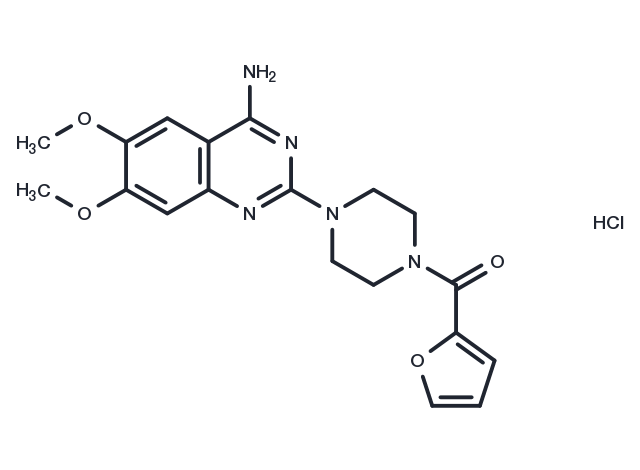Powder: -20°C for 3 years | In solvent: -80°C for 1 year


Prazosin hydrochloride (Vasoflex) reduces peripheral resistance and relaxes vascular smooth muscles as a selective adrenergic alpha-1 antagonist by a mechanism not completely known. Prazosin hydrochloride is a synthetic piperazine derivative with hypotensive antiadrenergic properties, It is used in the treatment of heart failure, hypertension, pheochromocytoma, Raynaud's syndrome, prostatic hypertrophy, and urinary retention.

| Pack Size | Availability | Price/USD | Quantity |
|---|---|---|---|
| 100 mg | In stock | $ 50.00 | |
| 1 mL * 10 mM (in DMSO) | In stock | $ 50.00 |




| Description | Prazosin hydrochloride (Vasoflex) reduces peripheral resistance and relaxes vascular smooth muscles as a selective adrenergic alpha-1 antagonist by a mechanism not completely known. Prazosin hydrochloride is a synthetic piperazine derivative with hypotensive antiadrenergic properties, It is used in the treatment of heart failure, hypertension, pheochromocytoma, Raynaud's syndrome, prostatic hypertrophy, and urinary retention. |
| In vitro | Prazosin leads to a significant increase in VEGF concentration in endothelial cells and angiogenesis only if eNOS is present. Prazosin binds to the α1-adrenergic receptors that are present on smooth muscle cells surrounding all larger blood vessels. [1] Prazosin (0.1 nM) blocks the increases in perfusion pressure caused by electrical stimulation of the perimesenteric nerves but does not significantly reduce the vasomotor effect of exogenous noradrenaline. [2] |
| In vivo | Prazosin application leads to the expansion of the capillary system by modulation of the hemodynamic environment (flow rate, shear stress) in skeletal muscle. Prazosin induces angiogenesis in extensor digitorum longus (EDL) muscles of C57BL/6 mice but not eNOS-knockout mice. [1] Prazosin (0.5-2.0 mg/kg) blocks Yohimbine-induced reinstatement of food and alcohol seeking, as well as footshock-induced reinstatement of alcohol seeking in rats. [3] Prazosin (0.2 mg kg(-1) s.c.) causes an enhancement of a suppression of conditioned avoidance response in the presence of the dopamine D2 receptor antagonist raclopride (0.05-0.20 mg/kg s.c.) in rats. [4] Prazosin administration alone (1 mg/kg, s.c.) only slightly reduces horizontal activity during an initial 10 min measurement period, although it consistently reduces rearing in freely moving rats. Prazosin effectively suppresses the locomotor stimulation caused by either dose of MK-801 throughout the whole observation period in freely moving rats. [5] |
| Synonyms | Prazosin hydrochloride, Prazosin HCl, cp-12299-1, Peripress, Vasoflex, Minipress |
| Molecular Weight | 419.86 |
| Formula | C19H22ClN5O4 |
| CAS No. | 19237-84-4 |
Powder: -20°C for 3 years | In solvent: -80°C for 1 year
Ethanol: 5 mM
DMSO: 55 mg/mL (131 mM)
You can also refer to dose conversion for different animals. More
bottom
Please see Inhibitor Handling Instructions for more frequently ask questions. Topics include: how to prepare stock solutions, how to store products, and cautions on cell-based assays & animal experiments, etc.
Prazosin hydrochloride 19237-84-4 Autophagy GPCR/G Protein Immunology/Inflammation Membrane transporter/Ion channel Neuroscience Potassium Channel MRP Adrenergic Receptor ABC alcohol pressure transporters organic Prazosin Hydrochloride Inhibitor Beta Receptor high receptor cation adrenergic Prazosin HCl cp-12299-1 Norepinephrine use disorders efflux inhibit Peripress Vasoflex 45Ca Prazosin blood Minipress inhibitor
